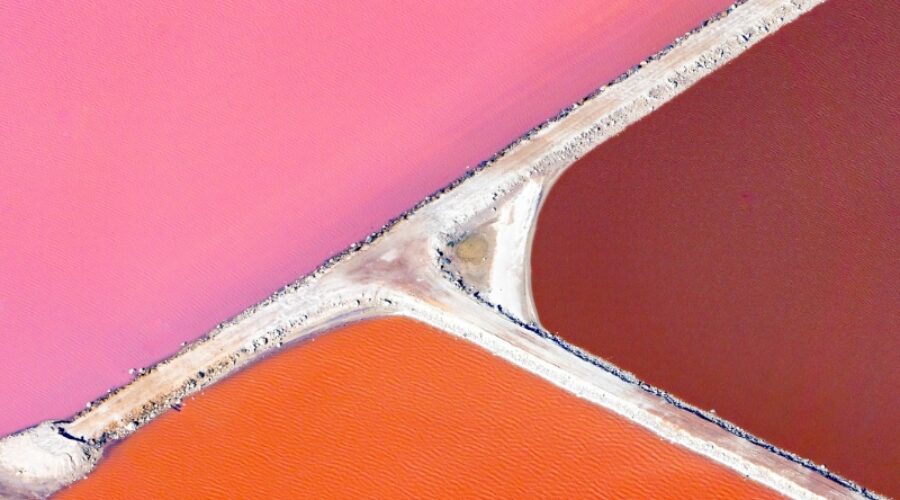41 Pink Lakes in 22 Countries with Map
Pink lakes, a captivating natural phenomenon, draw worldwide attention for their startling shades ranging from a soft pastel pink to vibrant hues of red. But experts warns us that there will be many more going forward due to climate change.
You can find the most pink lakes in Australia, which is 15 if we only count the larger ones. But there are pink lakes in 22 countries worldwide.
Please note the pink color in many lakes are temporary. The intensity and shade of pink or red can fluctuate based on factors like temperature, salinity, and the presence of microorganisms, making each pink lake a unique ecosystem. The weather has to be dry and hot to turn many lakes in the list a dark shade of pink.
What is a pink lake?
These unique bodies of water get their distinctive coloring primarily from a combination of high salt content and the presence of salt-tolerant algae such as Dunaliella salina or bacteria like Halobacterium salinarum or Halobacterium cutirubrum. These algae produce carotenoids, which are organic pigments that contribute to the pink and red coloration observed in pink lakes.
It is not the same for pink sand beaches, where the color comes from a micro-organism called Foraminifera.
While pink lakes are popular for their photogenic qualities, they are also of scientific interest. They serve as natural laboratories for studying extremophiles and halophiles—organisms that thrive in high-salt environments.
Map
Here is the map of all 41 pink lakes in the world. Click here to browse it through Google Maps.
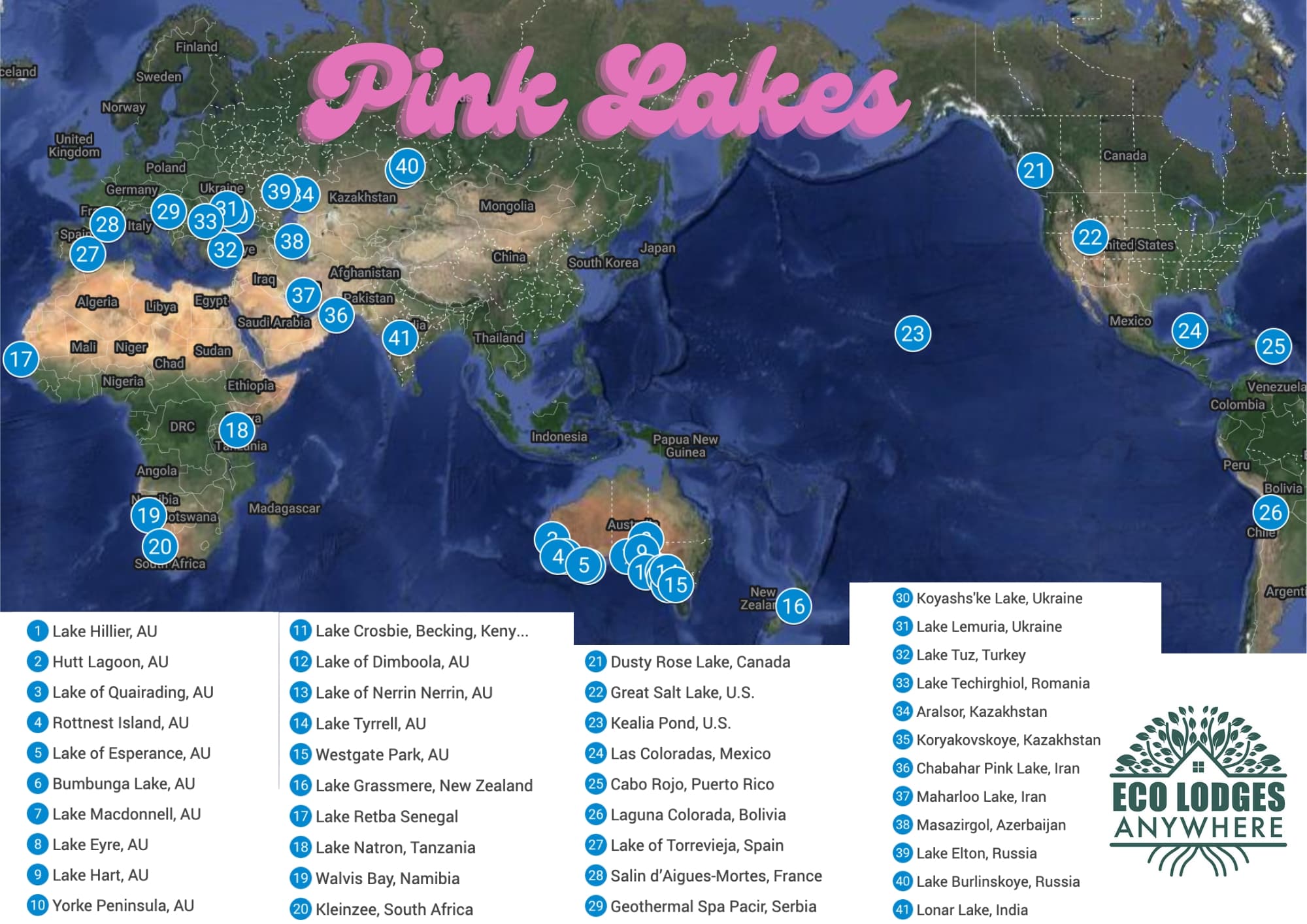
Australia and New Zealand
Lake Hillier, Western Australia
Lake Hillier, discovered in 1802 by Matthew Flinders, is famed for its vivid pink color, visible even when water is taken in a glass.
Situated on Middle Island, Western Australia, this small lake, 600 meters long and 250 meters wide, is fringed by eucalyptus and paperbark trees. Although it was once used for salt extraction, it is not anymore.
Swimming in the lake is safe but since it is a nature reserve access is limited for tourists. You can fly over the lake to see it though which gives the best view.
Hutt Lagoon, Western Australia
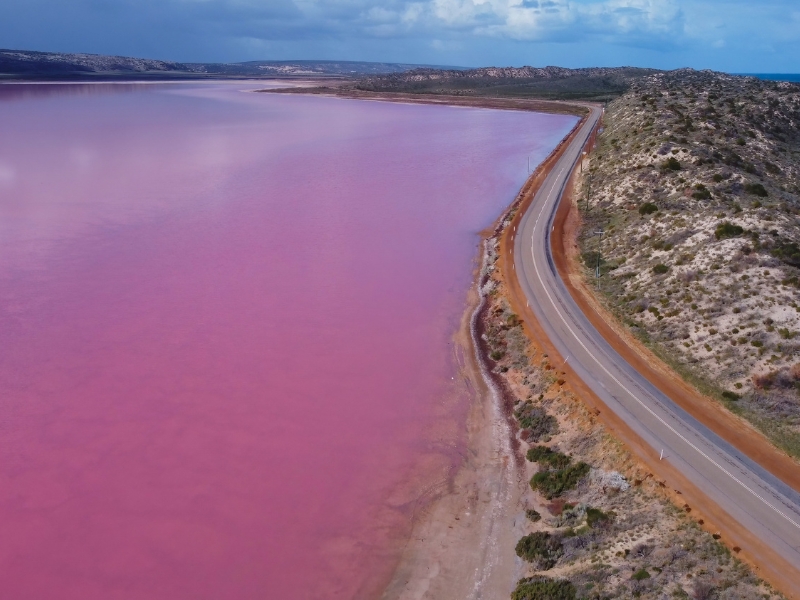
Hutt Lagoon, situated on the drive between Port Gregory and Kalbarri in Western Australia, offers a kaleidoscope of colors from bubblegum pink to lilac and sometimes red, especially stunning before sunset.
Accessible via a six-hour drive from Perth along the Indian Ocean Drive or a quick 30-minute journey from Kalbarri, it also features scenic flights from Geraldton for an unparalleled view.
The lagoon’s vivid colors, influenced by high salinity, change with seasons and time, best observed mid-morning or sunset from July to September.
Lake Quairading, Western Australia
Quairading is a town located in the Wheatbelt region of Western Australia. It is situated approximately 100 miles east of Perth, the state’s capital.
Quairading serves as a hub for the surrounding agricultural community, which is primarily focused on crop farming and sheep grazing. The area is known for its scenic beauty, including natural reserves and wildflowers. While the lake does not often turn pink, it is still a point of interest. The best time to catch the link pink is during dry, hot summer.
Rottnest Island, Western Australia
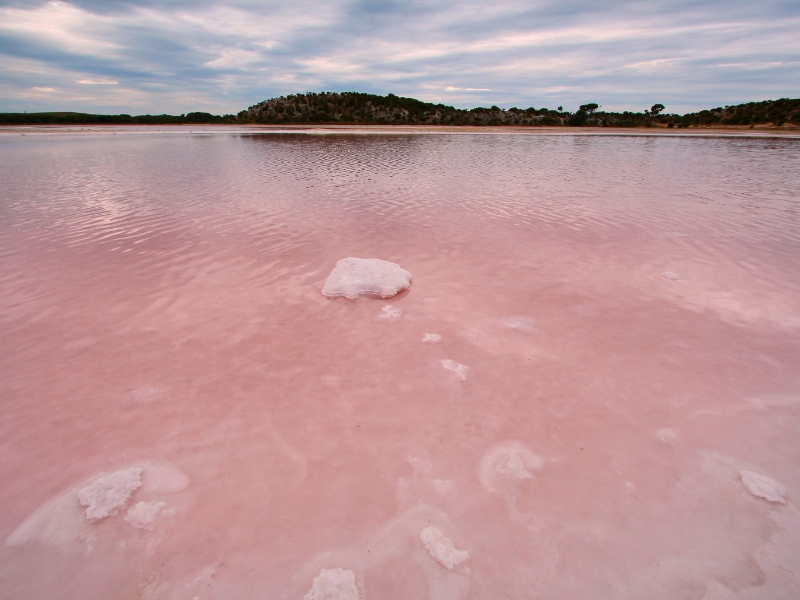
Wadjemup / Rottnest Island boasts a unique ecosystem, with 12 salt lakes covering over 200 hectares, making up 10% of the island. These lakes are four times saltier than the Indian Ocean.
The island’s flora, adapted to high salt levels, thrives around these lakes. The area, featuring microbialites and diverse plant life, offers a network of trails for exploration.
Notably, the Gabbi Karniny Bidi trail provides stunning views, especially of the lakes’ reflective surfaces at sunset. Swimming in these lakes is not advised due to the high salinity. Guided tours including the ferry ride is the easiest way to get there.
Pink and Rainbow Lakes of Esperance, Western Australia
Lake Spencer is one of the largest pink lake near Esperance, but it lost its pink color in 2017. Fly Esperance offers a tour over the Rainbow Lakes.
Interesting fact: Esperance Distillery developed a pink gin in honor of the pink lakes.
Lake Bumbunga, South Australia

Lake Bumbunga, located near Lochiel, 80 miles north of Adelaide, offers a striking visual treat with its bubble gum shores. This lake is nestled between the Clare Valley and Yorke Peninsula tourist regions, known for their scenic beauty and Australian riesling wine.
To visit, drive north from Adelaide via Port Wakefield Road towards Lochiel. But visitors should not drive on the lake itself.
Interesting fact: In 2021, visitors could find an interesting tire sculpture known as the Loch-eel, humorously linked to the mythical Loch Ness Monster. It was placed there to enhance the pink lake’s appeal. Sadly or not, but it is no longer there.
Lake MacDonnell, South Australia

Lake MacDonnell, located near Penong on the Eyre Highway, is a striking natural wonder. Known for its former salt mine and as Australia’s largest gypsum mine, it’s particularly famous for its vibrant pink and blue waters divided by a road (aka Watermelon Avenue), creating a stunning visual contrast.
The colors result from algae and bacteria interacting with the lake’s high salinity. Best visited after rain for its most vivid hues. The lake offers no facilities, so visitors should plan accordingly and respect the delicate environment.
Lake Eyre (Kati Thanda), South Australia
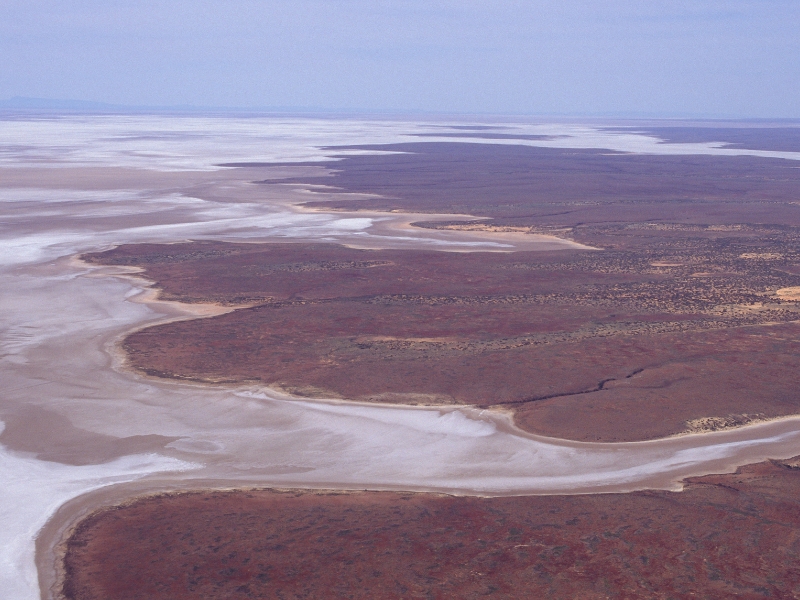
Kati Thanda-Lake Eyre, located in South Australia’s Outback, is the country’s largest salt lake with a total area of 4,281 square miles. It is actually two lakes connected with a canal called Goyder Channel.
It offers the best views, when flooded by rain. When it does, the lake has an extraordinary color change to pink, due to salt-loving algae. It stands in contrast with the glittering white salt crust.
It is located approx. 450 miles from Adelaide and easily accessible by plane or by car. But before going check water levels and this bulletin about public access routes.
Interesting fact: The lake is usually dry. It was only full entirely three times during the past 100 years. 1984 was the last year it was full, but it can be partially filled from time to time.
Lake Hart, South Australia
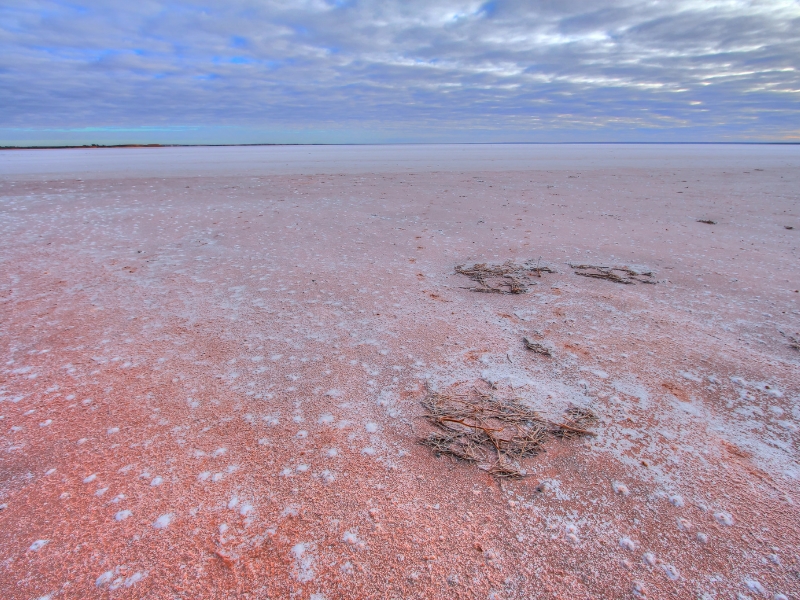
Lake Hart is a large salt lake approx. 40,000 acres near Woomera, in South Australia. It is usually dry but can fill with water partially when it rains. When it does, the water may turn a light pink color.
The lake doesn’t have major rivers flowing into it. Instead, it collects rainwater and run-off from smaller local creeks and streams. The pink hue comes from algae and salt-loving organisms that thrive in the saline water.
Interesting fact: The area around Lake Hart is known as an old weapon and rocket testing site. An 6A rocket launcher is placed on its north-east side as a memento.
200 Pink Lakes, Yorke Peninsula, South Australia
The Yorke Peninsula in South Australia is a picturesque region surrounded by approximately 200 salt lakes, which are a legacy of its history in commercial salt production. These lakes, such as Lake Fowler, ranging from white to vibrant pink to even blue, influenced by their salinity levels and the time of year.
The Yorke Peninsula Salt Lake Trail offers routes that guide visitors to stunning vantage points for photography, especially during sunrise and sunset. Along the trail, interpretative signs share the history of salt production, and visitors can also explore historical sites like old school ruins and cemeteries.
Lake Crosbie, Becking, Hardy, and Kenyon, Victoria
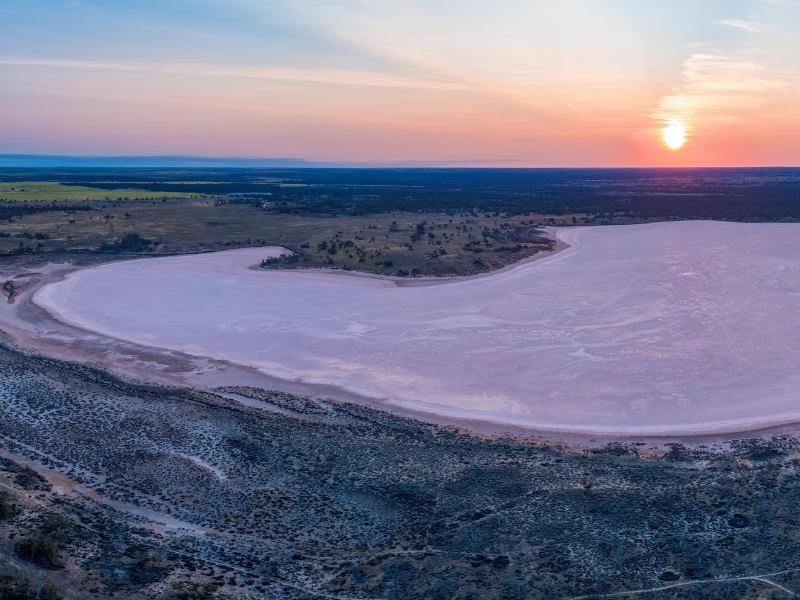
The Murray-Sunset National Park in Victoria is home to the Pink Lakes, including Lake Crosbie, Lake Becking, Lake Hardy, and Lake Kenyon. These lakes get their pink hue from the algae and halobacteria that produce beta-carotene, a pigment also found in carrots, which flourishes in the high salt content waters especially after winter and spring rains.
As the water evaporates, it leaves behind salt and minerals that contribute to the lakes’ color changes, which can vary from deep pink to a bright, glistening white. Visitors can enjoy walks, camping, and the unforgettable sunsets that give the park its name. The park’s Pink Lakes are known to be a must-see attraction in Victoria.
Loch Iel, Dimboola, Victoria
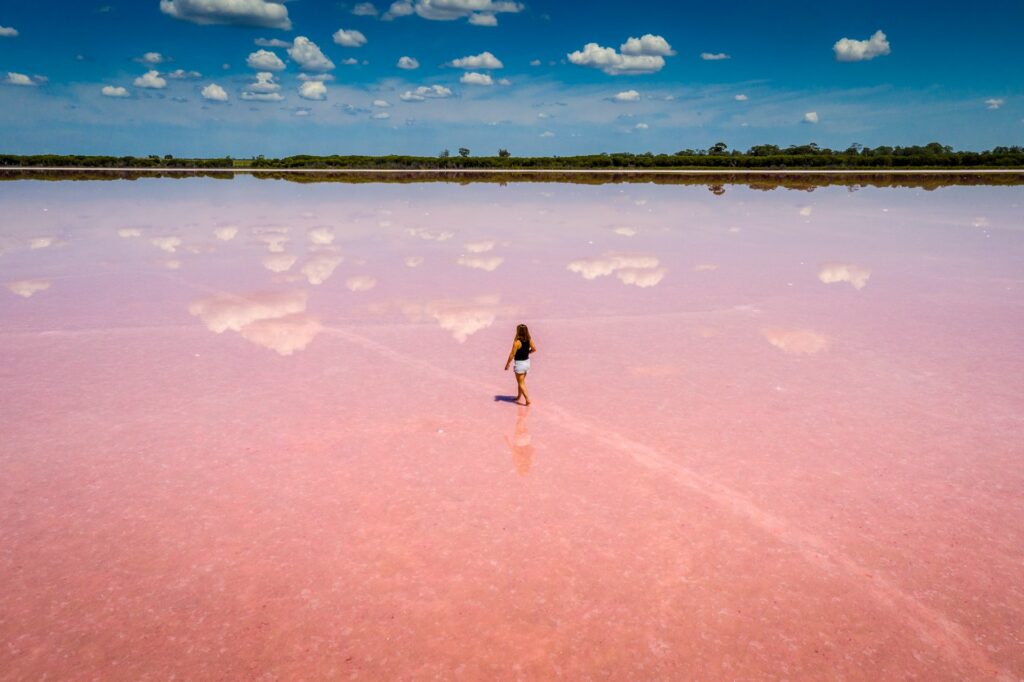
Pink Lake, near Dimboola in Victoria, is set within the Wotjobaluk Aboriginal cultural landscape. The Traditional Owners, the Wotjobaluk, Jaadwa, Jadawadjali, Wergaia, and Jupagalk Peoples, maintain a strong connection to this land. Located just off the Western Highway, north of Dimboola and Little Desert National Park, the lake is a photographer’s paradise, offering a surreal landscape that changes in color with the seasons.
The lake’s edges are fringed with yellow gumtrees and salt paperbarks, creating a serene setting. The intensity of the color varies from bubble-gum to a subtle salmon tint.
Visitors can easily access Pink Lake from the adjacent highway rest stop, where facilities like picnic seating, shelters, and toilets are available. The lookout provides sweeping views of the lake, perfect for a scenic break or a photo session.
Pink Lake Wildlife Reserve, Nerrin Nerrin, Victoria
The Pink Lake Wildlife Reserve near Nerrin Nerrin, Victoria, is a less-documented natural site. Situated close to the small town of Nerrin Nerrin, information about accessing the lake and its features is scarce, but there are photos on social media showing a pink lake there.
Lake Tyrrell, Victoria

Lake Tyrrell in Victoria is Australia’s largest salt lake, offering spectacular views, especially at sunrise and sunset when its surface reflects the sky. It is popular for stargazing and photography, due to its mirror-like qualities under certain conditions. There is also significant cultural site for the local Indigenous community. The name of the lake also comes from the Aboriginal word “Tyrille” meaning sky or space.
Westgate Park, Melbourne, Victoria
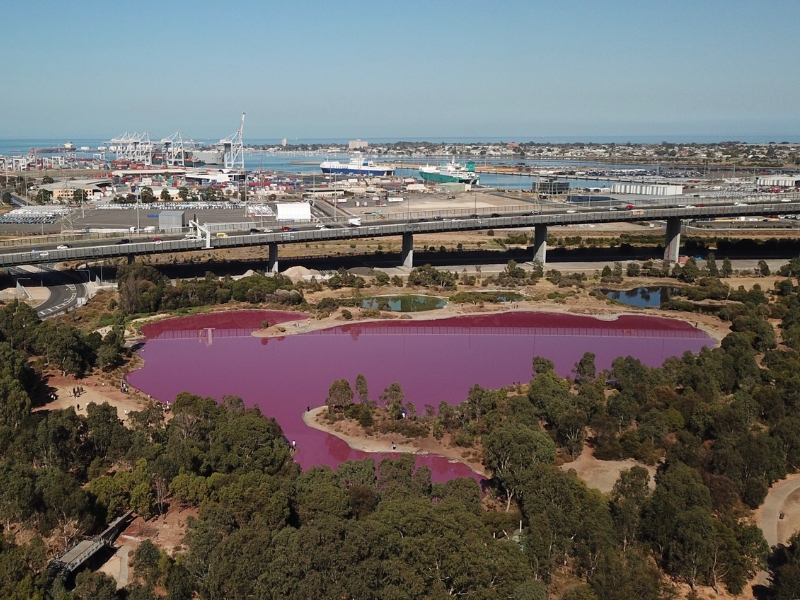
Westgate Park in Melbourne, located beneath the Westgate Bridge, is known for its temporarily pink lake. The lake turned dark pink in 2020, but as of now, the lake has returned to its usual color. Although the pink coloration was not permanent, the park remains a popular spot for its natural beauty and continues to attract visitors for its flora, fauna, recreational spaces and city views.
Lake Grassmere, New Zealand

Lake Grassmere (also known as Kapara Te Hau) in New Zealand is known for its salt production. Situated in the Marlborough region, this shallow coastal lake undergoes natural evaporation in summer, leaving behind crystallized salt. The process is enhanced by the addition of seawater, producing large quantities of salt annually.
These unique conditions also sometimes give the ponds a pinkish hue, similar to other pink lakes around the world, attributed to certain types of algae. Lake Grassmere (operated by Dominion Salt) is a significant industrial and natural site, contributing importantly to New Zealand’s salt supply.
Africa
Lake Retba, Senegal

Lake Retba, or Lac Rose, is situated approx. 20 miles northeast of the Senegalese capital, Dakar. The lake’s striking pink color is thanks to the presence of the algae Dunaliella salina, which produces beta carotene as a part of its photosynthesis process, while the high salt content attracts halobacteria, adding to the tint.
This salt-laden lake supports a local industry that involves salt harvesting, which is a crucial aspect of the region’s economy. Swimming is allowed, but note that it is only pink during the dry season (November to June), and it may lose its color during the wet season.
Interesting fact: Until 2009, Lake Retba (Lac Rose) in Senegal was famous for being the finish line of the Paris-Dakar Rally. After the rally moved out of Africa in 2009, the Africa Eco Race took its place, continuing the tradition of concluding at the scenic shores of Lac Rose.
Lake Natron, Tanzania

Lake Natron in Tanzania is a striking example of an alkaline, or soda lake, characterized by high levels of sodium carbonate which contribute to its alkalinity, with a pH around 10.5.
It creates a harsh environment where only few species can thrive, yet it supports specialized ecosystems, including algae, brine shrimp, and lesser flamingos that breed there since predators avoid the area.
Due to it high salt content, swimming is prohibited. To compare it with ammonium hydroxide (NH4OH) that has a pH of 10.09, and causes skin allergies, eye damage, or skin damage among others.
Interesting fact: It gained significant media attention as “being deadly” when a photographer Nick Brandt discovered calcified animals that were washed to the shore. He repositioned them to took photos of the stone-like animals which he later published in Across the Ravaged Land (2010-2012).
Walvis Bay, Namibia
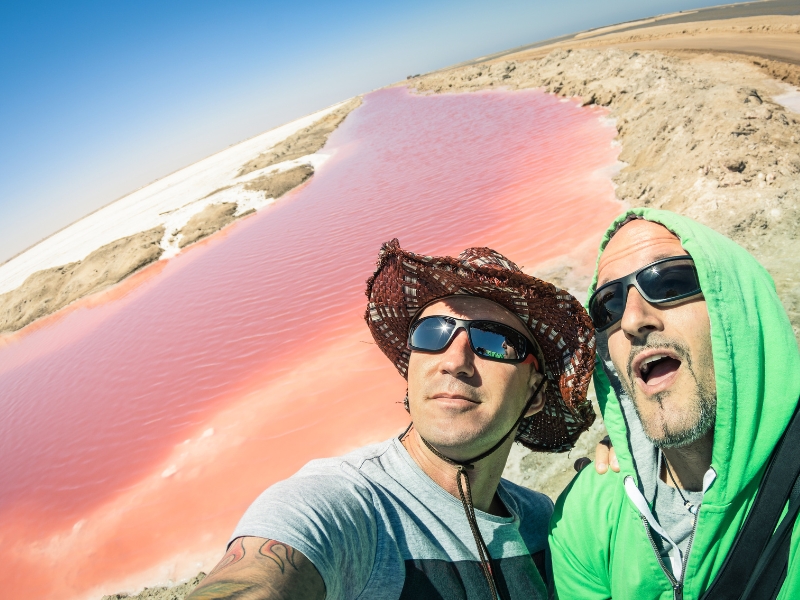
The Salinas de Walvis Bay is located between the mouths of the Swakop and Kuiseb rivers in Namibia and are renowned for their extensive salt pans, which play a significant role in the country’s salt production.
This picturesque location, set against the backdrop of the Atlantic Ocean, not only contributes economically through salt extraction but also serves as a vital habitat for diverse birdlife, including flamingos and pelicans. Walvis Bay is also considered one of the most important wetlands for birds along the southern African coast.
Interesting fact: With over 150,000 migratory birds flocking here during the summer, this location is a haven for birdwatchers. The area boasts more than 150 recorded bird species, making it a vibrant and diverse habitat for avian life.
Kleinzee, South Africa
Near Kleinzee, a small coastal town in Northern Cape, South Africa, lies an artificial lake created by De Beers for recreational activities after they discovered diamonds in the area in 1925.
Following De Beers’ departure in 2010 and the cessation of ocean water pumping, the lake began to dry, leading to a significant increase in salinity and caused the water to turn a distinctive pink hue.
However, based on recent feedback from visitors, the lake is now completely dried up. Here is a short footage from 2016 to see what it looked like.
Americas
Dusty Rose Lake, Canada
In the secluded wilderness of Tweedsmuir Park in British Columbia, Dusty Rose Lake presents an unusual pink shade due to mineral compositions in the area.
It is an anoxic lake, which means there is no oxygen, thus no wildlife. Not even micro organisms. However, the lake does stands out as a natural wonder against the typical blue waters of other Canadian lakes.
WHERE TO STAY – Find the most sustainable eco-lodges in British Columbia.
The Great Salt Lake, Utah, US

The Great Salt Lake’s North Arm astonishes visitors with its pink waters, a stark contrast to the typical blue-green of the South Arm.
This unique hue emerged after a causeway built in the late 1950s divided the lake, increasing the North Arm’s salinity to about 30%, double that of the South Arm. This environment supports salt-tolerant archaea, which use a pink or purple protein to convert light into energy, coloring the water pink.
Interesting fact: The Spiral Jetty, near Rozel Point, is a famous 1,500-foot-long earthwork sculpture created by artist Robert Smithson in 1970. It is also great location to enjoy the pink lake without the crowds since it is a remote spot. If you go there, you get to experience two interesting sights at the same time.
Kealia Pond, Hawaii, US
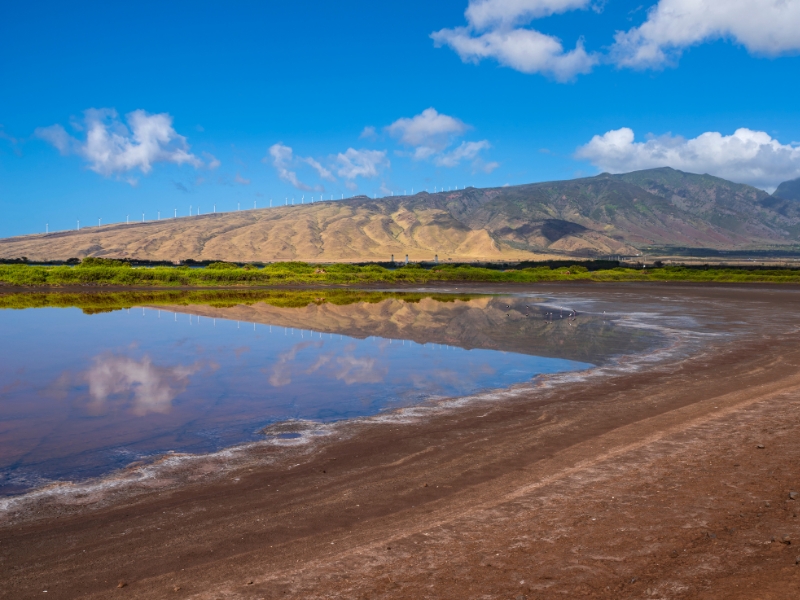
Keālia Pond National Wildlife Refuge in Hawaii is the latest addition to the list of pink lakes since it turned pink at the very end of 2023. Staff from the U.S. Fish and Wildlife Service have been monitoring this occurrence since October 30, collaborating with academic institutions to understand the cause.
Preliminary findings suggest a significant presence of Thiohalocapsa bacteria, part of the purple sulfur bacteria group, known for their role in the sulfur cycle and ability to thrive in oxygen-depleted environments.
Visitors to Maui are advised to admire this spectacle from a distance, adhering to safety guidelines and refuge policies.
WHERE TO STAY – Find the most sustainable eco-lodges in Hawaii.
Las Coloradas, Mexico

Las Coloradas Tourist Park in Yucatán is a visual feast beyond its famous pink salt lagoons. The vivid blue skies, pristine white sands, and the varied hues of the salt ponds create a stunning natural palette. Salt production is important to that area and the huge salt mountains are adding to its scenic beauty.
The color spectrum of the lagoons changes with production and weather so check with the tourist park. The area’s rich biodiversity, including pink flamingos and turtles, enhances its charm and making Yucatán a destination not only to explore cenotes and Mayan ruins.
WHERE TO STAY – Find the most sustainable eco-lodges in Mexico.
Las Salinas de Cabo Rojo, Puerto Rico

Las Salinas de Cabo Rojo refers to the salt flats in Puerto Rico, where shallow waters turn various shades of pink due to the concentration of salt and microalgae. These salt flats are not only a fun thing to do, but also an important economic resource for the region.
The Cabo Rojo Salt Flats reaches to more than 500 hectares. It is also an important birding location, hosting a total of 28 shorebird species and a three storey lookout. The park is under the protection of U.S. Fish and Wildlife Service.
WHERE TO STAY – Find the most sustainable eco-lodges in Puerto Rico.
Laguna Colorada, Bolivia
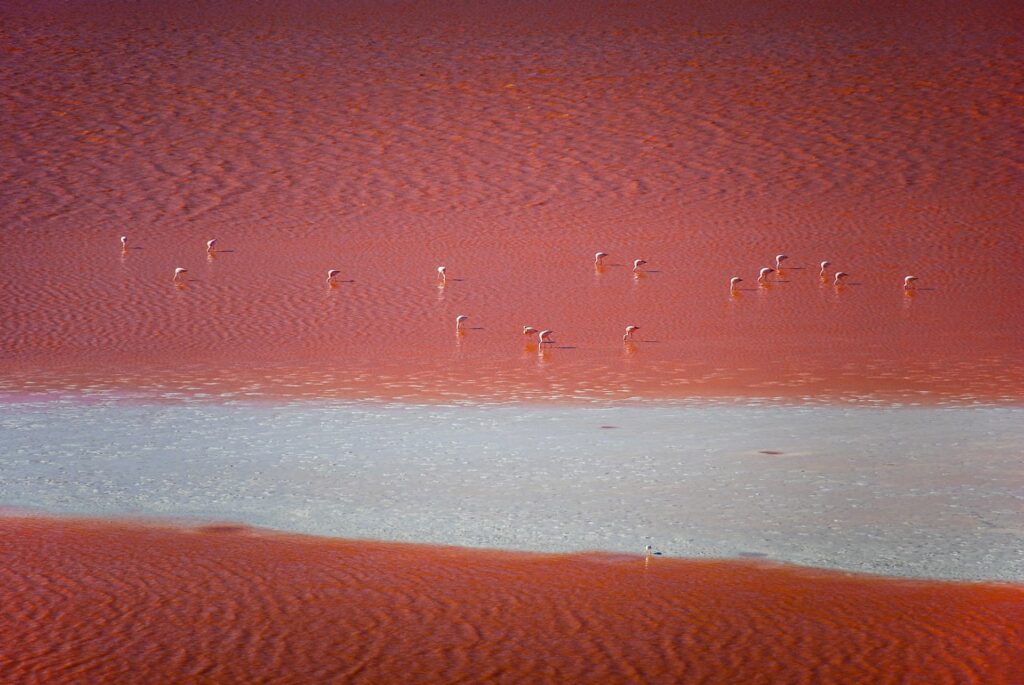
Located at an altitude of 4,278 meters, Laguna Colorada within the Eduardo Avaroa Reserve is a marvel of nature. Its distinctive pink-red waters, due to algae and sediment, create a vital habitat for the James’s flamingo, one of three flamingo species found in the area.
This high-altitude wetland, sprawling over 714,745 hectares, is a biodiversity hotspot in Bolivia’s Potosí Department, featuring over 190 plant species and a sanctuary for endangered wildlife like the Andean condor, fox, and puma.
Europe
Las Salinas de Torrevieja, Spain

In Spain’s Costa Blanca region, Las Salinas de Torrevieja stands out for its bubblegum-pink hues. Its coloration is thanks to halophilic bacteria and algae that flourish in high-salinity environments. It is a place for salt production with artificial lakes and large salt hills.
You can take a one-hour train ride around the site for a fee of EUR 9.50 for adults, and EUR 8.50 for children between 2 and 12 years (2024 prices). Alternatively, you can take a guided or unguided walk around the lakes. Please note that swimming is not allowed.
Les Salins d’Aigues-Mortes, France

In the Camargue region of France, Les Salins d’Aigues-Mortes showcases varying shades of pink. Microorganisms thriving in the saline conditions are credited with giving the lake its distinctive color.
Similar to the pink lake in France, Les Salins d’Aigues-Mortes also offers an approx. one-hour train ride around the site. The price is EUR 13 for adults, and EUR 9 for children between 5 and 13 (2024 prices).
Pačir Lake, Serbia
Pačir Lake offers a less-known but no less intriguing example of Europe’s pink lakes. Thermal Spa Pacir, between Novi Sad and Subotica in Serbia, featured a unique pink thermal lake, attracting attention since its establishment in 2014.
It is an artificial lake, about 2,000 square meters in size, equivalent to two Olympic pools. It changes color due to minerals like iodine, lithium, and bromine, reaching a concentration that creates its distinct pink hue and therapeutic qualities.
The spa, catering to 200 visitors with amenities like indoor pools and free parking, aims to become a tourist destination.
Koyashskoye Salt Lake, Ukraine
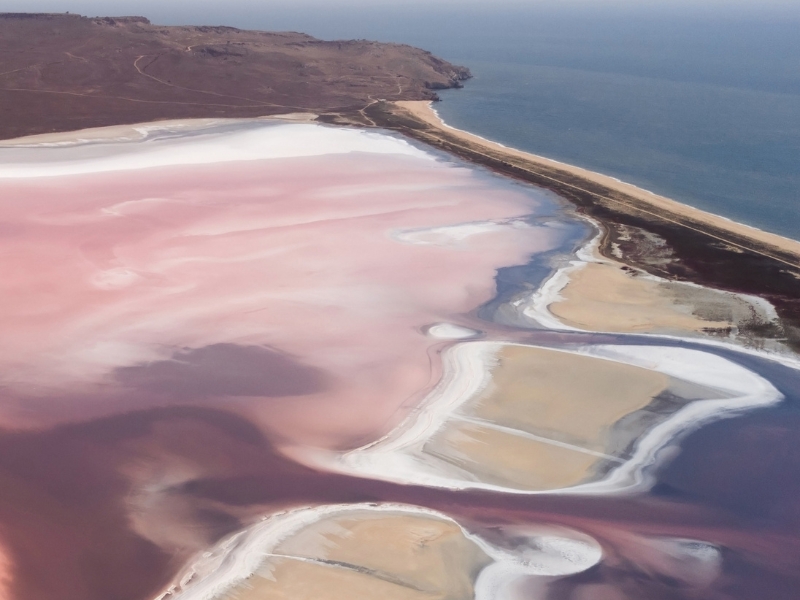
Koyashskoye Salt Lake is a shallow saline lake characterized by its pink to blood red color, in Crimea, Ukraine. The lake is more than 2.5 miles long and 1.2 miles wide. It separated by a thin strip of land from the Black Sea. The striking hue results from the Dunaliella algae reacting to the lake’s salt.
It is a destination off-the-beaten path, not widely known outside Ukraine. But locals often visit the lake, drawn by the belief in the therapeutic properties of its mud, which is thought to have healing powers.
Lake Lemuria, Ukraine
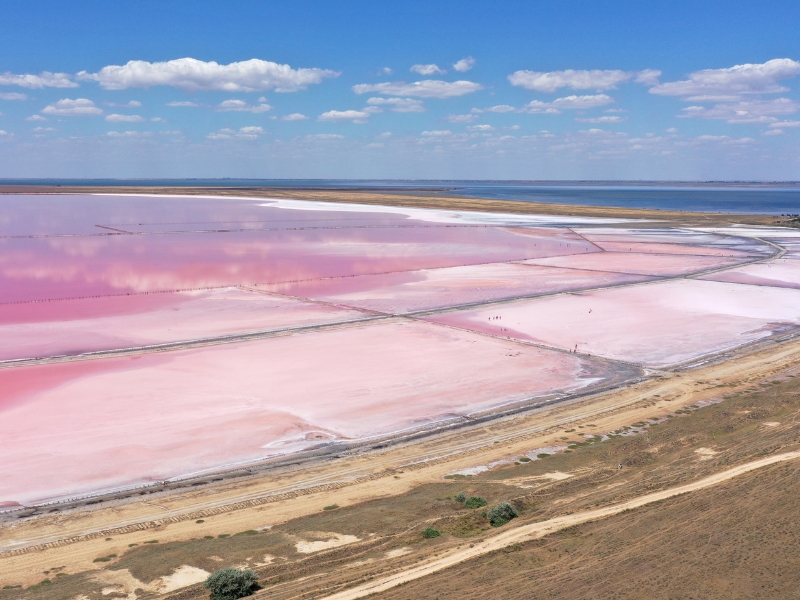
Lake Lemuria, nestled in Ukraine’s Kherson Region, boasts an extraordinary pink hue due to the micro-algae Dunaliella salina, which thrives in its waters with a salinity reaching up to 35%, higher than the Dead Sea.
The entire salt reserve of Lemuria Lake exceeds 200 million tons, highlighting its significant natural resource. This spectacle, along with the region’s rich biodiversity and historical landmarks like the Askania Nova Reserve, marks Kherson as a great destination for nature lovers and photographers.
Lake Tuz, Turkey

Lake Tuz (also known as Tuz Gölü), located in central Türkiye near Cappadocia, is the country’s second-largest lake, spanning 1,665 square kilometers. Known for its high salinity, the lake undergoes a remarkable transformation during summer, turning bright pink due to algae that produce a red-orange pigment in response to increased temperatures and salinity.
Lake Tuz is part of a Special Environmental Protection Area due to several reasons. One, 70% of salt is Turkey produced here. Two, it is the habitat of endangered flamingos in Europe. The lake can also be visited vie guided tours. This sunset tour must be magical with the pink lake in the background.
Lake Techirghiol, Romania
Lake Techirghiol, right off the coast of the Black Sea, in Romania turned pink for the first time in July 2023. Its stunning transformation attributed to the proliferation of algae amid rising temperatures.
Locals have been frequenting the lake for its sapropelic mud albeit the sulfur smell after the transformation got more robust, unpleasant.
Asia
Aralsor, Kazakhstan
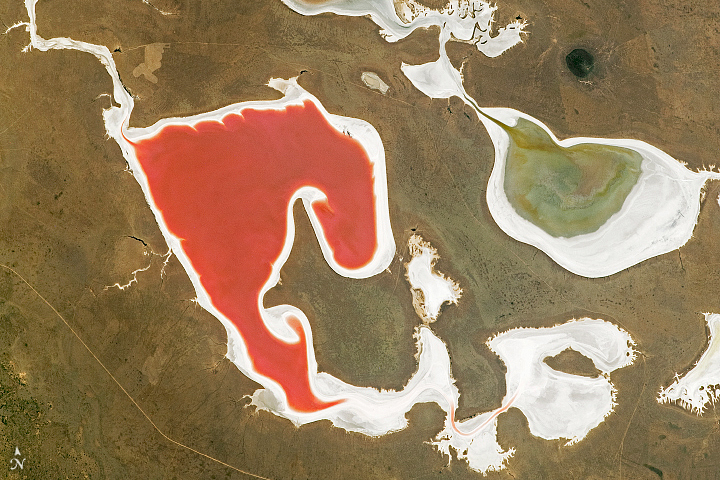
Aralsor Lake, found in Kazakhstan but lies close to the Russian border, features a pink hue attributed to its saline waters and the presence of algae that thrive in this high-salinity environment. It is between 48-77 sq mi.
Lake Koryakovka, Kazakhstan
Koryakovka Lake, also located in Kazakhstan, is notable for its pink coloration but that is probably all the information you can find about it.
Lipar Pink Wetland, Iran
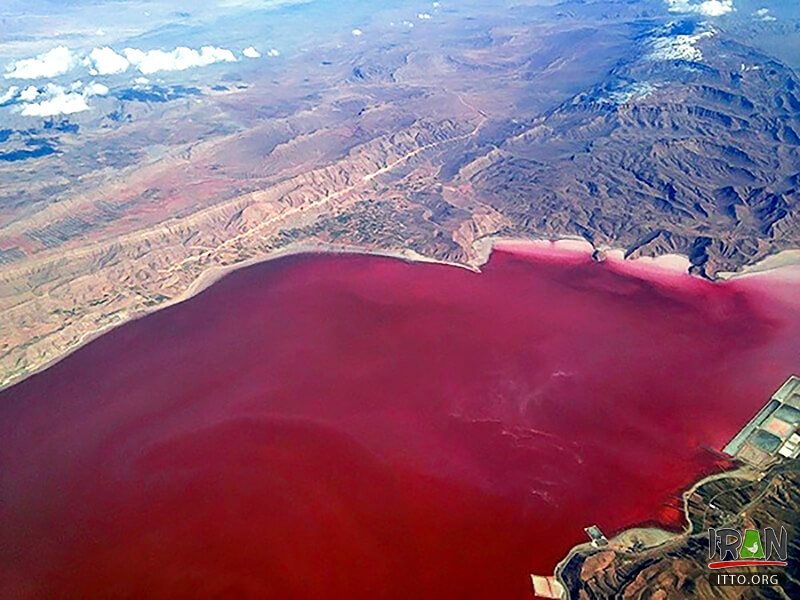
The Lipar Pink Wetland, covering about 4,000 hectares near Chabahar, Sistan and Baluchestan province, Iran, is noted for its pink hue due to planktons.
Situated just 200 meters from the Sea of Oman and close to the village of Lipar, it’s a vital habitat for aquatic birds like flamingos and marine life. This unique ecosystem, enriched by the rivers, draws tourists and photographers, especially for its boat tours and hiking opportunities along the scenic Chabahar Beach.
Maharloo Lake, Iran
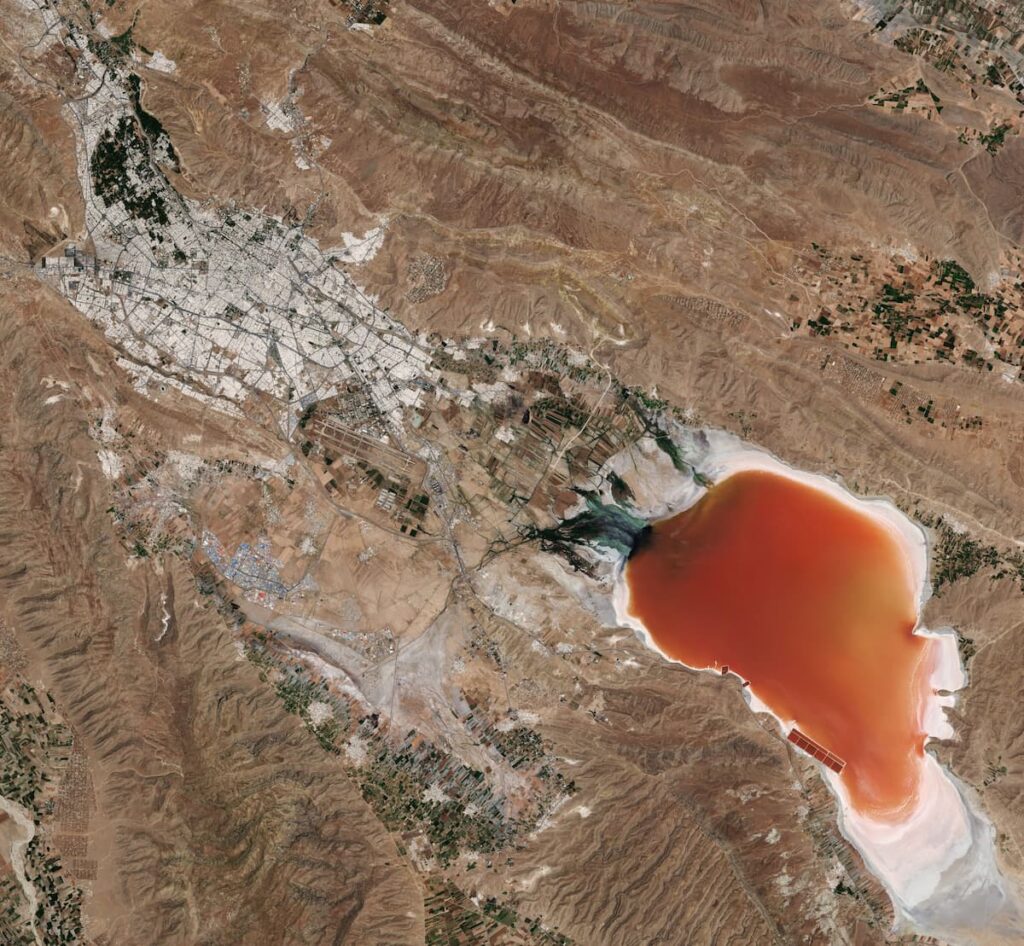
Maharloo Lake, near Shiraz, Iran, is a seasonal salt lake that turns pink due to the proliferation of algae and bacteria suited to its saline conditions. The intensity of the pink color can be seen especially in the summer months.
Masazirgol (Masazir Lake), Azerbaijan
In Azerbaijan, Masazirgol is a pink lake recognized for its high salt concentration, which supports the growth of halophile microorganisms, responsible for the water’s rose tint. It is a result of salt production that started in 1813. There is a fence around it, so getting to it is not easy.
Lake Elton, Russia
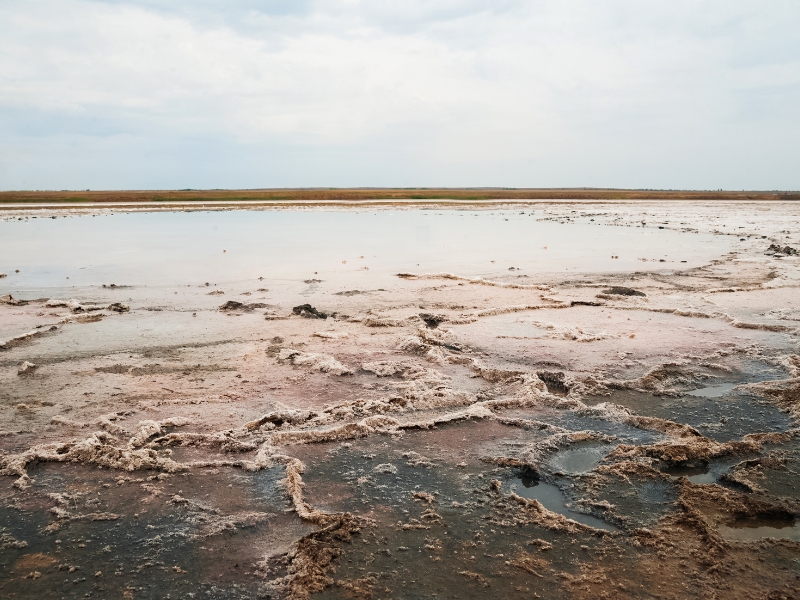
Lake Elton, located in the Volgograd region near the Kazakhstan border, is one of Europe’s largest mineral lake with 58 sq mi surface area. Originally, it was a salt mine that operated between 1747 and 1865. The lake’s salinity is higher than the Dead Sea’s, making it a valuable resource for health treatments in the nearby sanatorium.
Interesting fact: The Elton Salt Ultra is a unique ultramarathon in Russia, hosted around Lake Elton. It was last organized 2021, when it celebrated its 9th season.
Burlinskoye Lake, Russia
Burlinskoye Lake, found in Russia, stands out due to its impressive pink coloration. Much like its counterparts, it owes its unique palette to the presence of salt-tolerant algae that flourish in its saline waters. In the end of July and August, visitors get to see the darkest shade of pink it can get.
Interesting fact: There is a railway across the lake that carry the harvested salt. This aerial video shows this unique feature that no other pink lake has.
Lonar Lake, India
Lonar Lake first turned pink in 2020, but since then it turned back and force depending on the weather conditions. Scientists researched the reasons and found that lake also has a high number of single-celled algae called Dunaliella salina. When water conditions are favorable, the algae is green, if not, it turns pink.

FAQs
The pink hue of pink lakes is typically caused by the presence of algae or bacteria. Factors such as high salt concentration, sunlight, and the presence of specific types of bacteria and microorganisms contribute to the production of these pigments, resulting in the lakes’ distinctive pink color.
In Australia, there are 15 prominent pink lakes mostly in Western Australia, Victoria, and South Australia. Notable examples include Lake Hillier, Hutt Lagoon, or Lake Bumbunga.
Swimming in pink lakes is subject to local regulations and environmental protections. Some pink lakes permit swimming, but visitors must adhere to posted guidelines to avoid disrupting the ecosystem. Other lakes, due to their high salinity or conservation status, may not allow swimming to protect both the visitor and the lake’s environment.
Emese Maczko is a travel blogger behind Eco Lodges Anywhere. Having explored several destinations around Europe, the US, Indonesia, and Australia, and resided in Germany, the United Kingdom, and Luxembourg, Emese possesses a keen understanding of diverse cultures and an appreciation for the beauty of each destination she visits. She advocates for sustainable travel and ecotourism.

